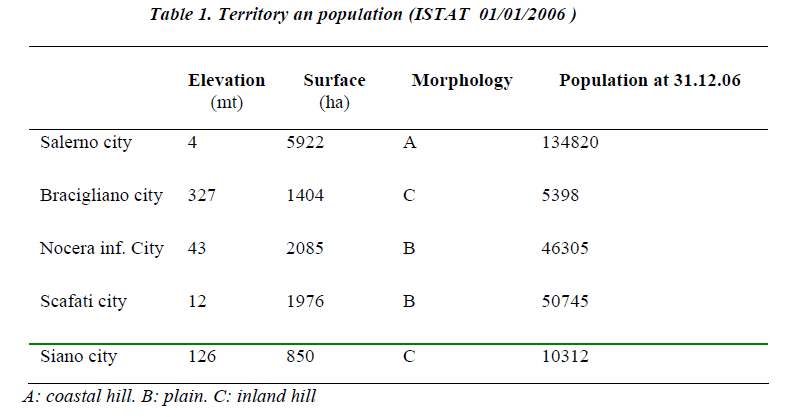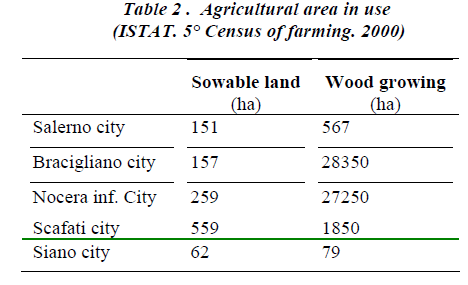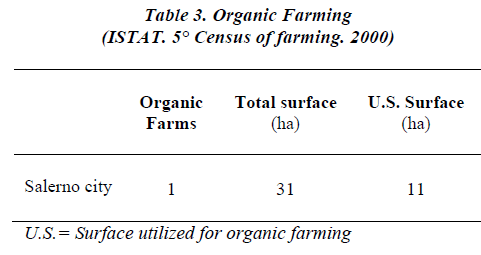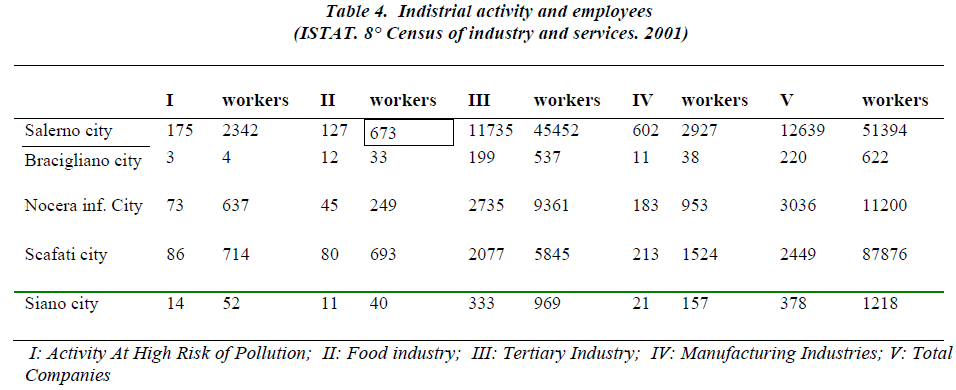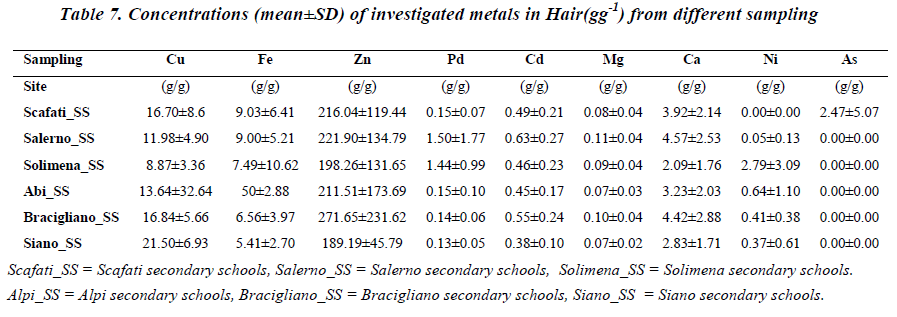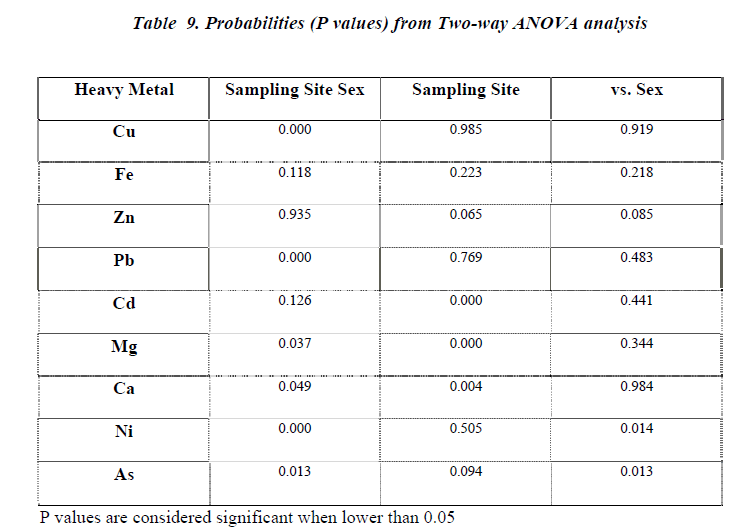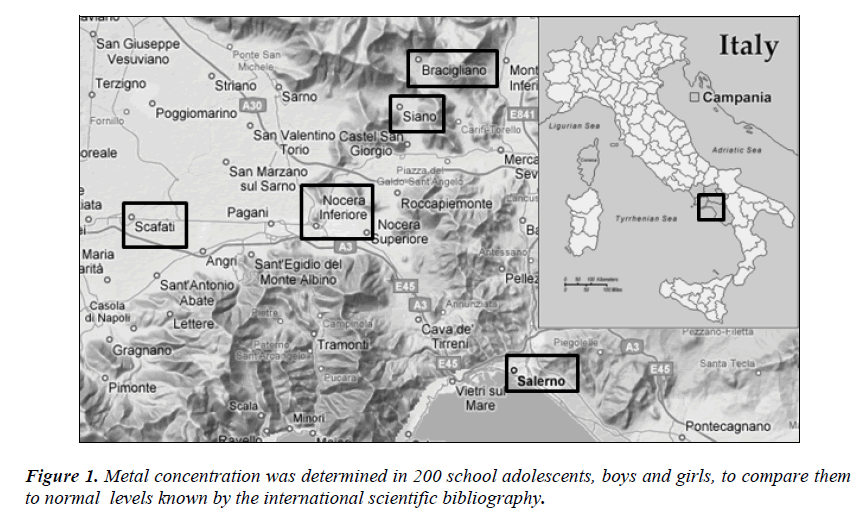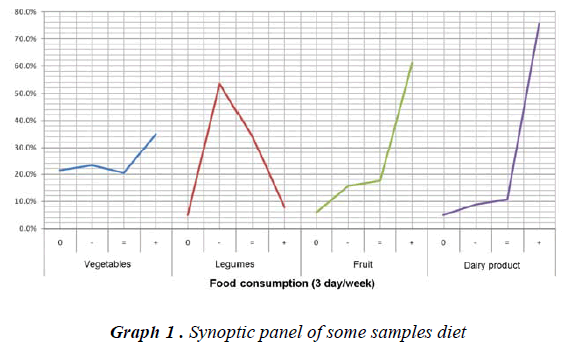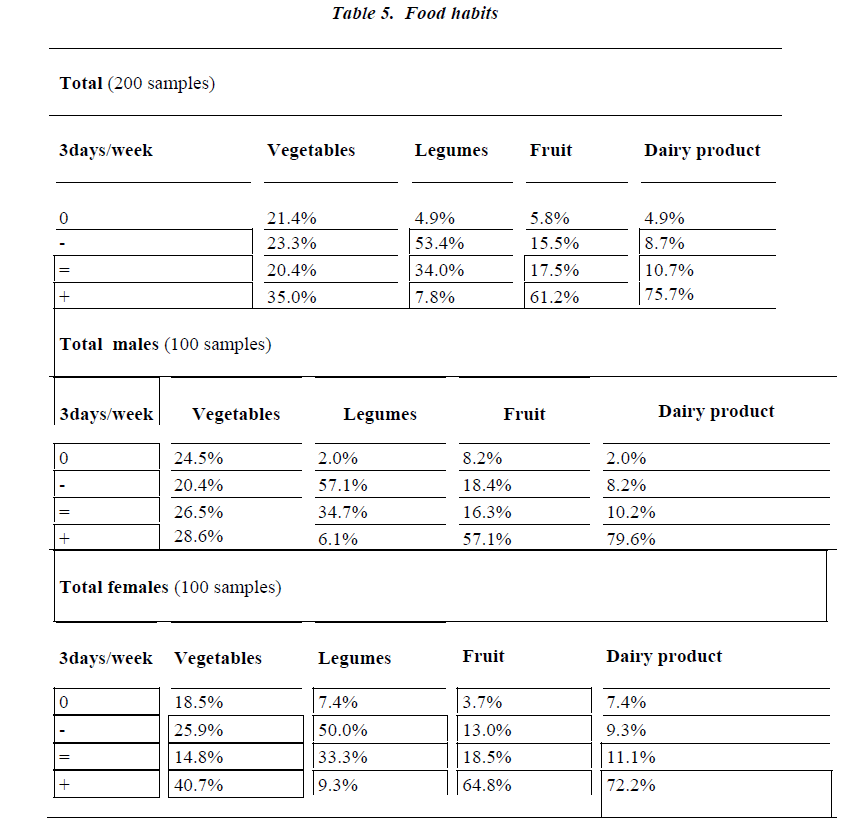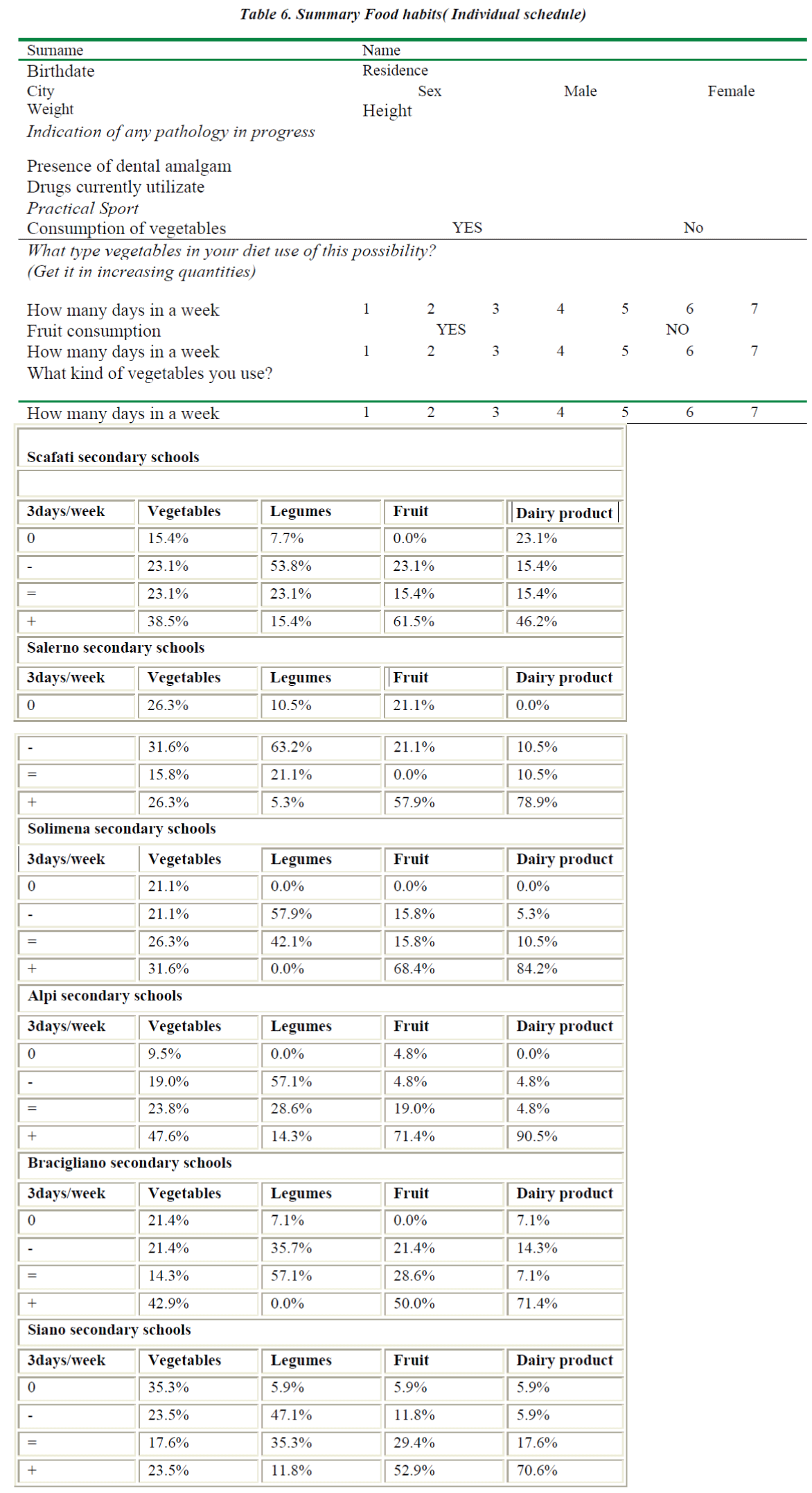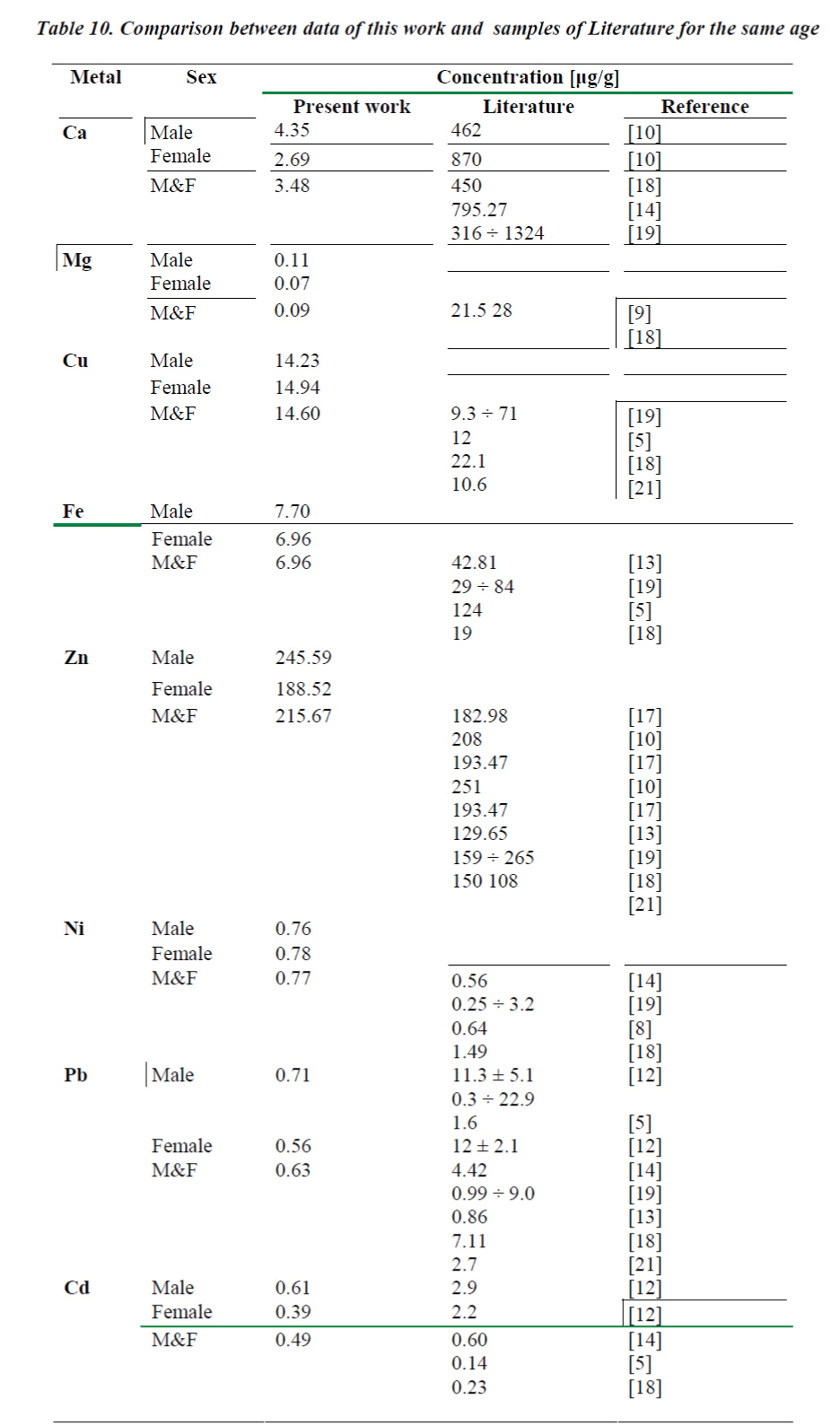- Biomedical Research (2010) Volume 21, Issue 2
Level of essential and toxic metals in urban adolescents hair: Preliminary study.
De Prisco P.P.a, Volpe M.G.a, Petitto F.a, Palladino C.b, Saturnino C.b, Capasso Ab, Di Stasio M.a*, De Prisco R .
aConsiglio Nazionale delle Ricerche - Istituto di Scienze dell’Alimentazione, via Roma 52°/c, 83100 Avellino, Italy;
bDepartment of Pharmaceutical Sciences, University of Salerno, via Ponte Don Melillo, 84014, Fisciano (SA), Italy.
- *Corresponding Author:
- Capasso A
Department of Pharmaceutical Sciences
University of Salerno
via Ponte Don Melillo
84014, Fisciano (SA)
Italy.
E-mail:annacap@unisa.it
Accepted date: Februay 07 2010
Abstract
The aim of this work is to monitor essential metals Ca, Cu, Fe, Mg, Ni and Zn, and xenobi-otic environmental metals As, Cd and Pb in hair of young boys. It is a strategic choice that could allow a preliminary study for a synergistic assessment of the possible relationships among diet and environmental local pollution in students of 12 - 13 years old, living in dif-ferent cities of Salerno province with different grade of urban and industrial development and the presence of water pollution (Sarno river and its tributaries) (Figure 1). It’s known that the age and sex samples, for their growth physiological features, are suited to this study. The experimental data, reported in table and compared to reference data, showed signifi-cant ponderal difference in metal levels between the samples collected by sex. Concentration of the above-mentioned elements were determined by means of atomic absorption spec-trometry after a washing procedure following a mineralization in a microwave digestion sys-tem. Particularly the arithmetic mean value of concentrations of lead in hairs of schoolboys of “Salerno” and “Solimena” secondary schools, were 1.50 g/g and 1.44 g/g; moreover “Solimena” schoolboys present a value of nickel (2.79 g/g) highest in comparison with other sampling sites; at last “Scafati” secondary school children’s hairs have a unsafe con-centration of arsenic (2.47 μg/g). Two-way ANOVA demonstrates a significant interaction between sampling site and sex on hair arsenic and nickel levels (P=0.013 and P=0.014 re-spectively) as well as a significant effect of sex and sampling site on cadmium, calcium, cop-per, lead and magnesium levels (P<0.05). The results support the hypothesis that hair metals levels can be considered an indicator of different relative exposure of populations to essen-tial and toxic metals pollution.
Key words
Metals; biomolecular; bioindicator; hair; pollution
Introduction
The impact of environmental exposure to toxic metals on human health has been discussed in numerous publications over the past 20 years, especially with respect to lead and cadmium [1-12]. Evaluation of the toxic effects of Cd and Pb on people living in polluted areas is based mainly on analysis of the concentrations of those metals in blood and urine and the accompanying biological effects [1-12].
Hair can accumulates not only toxic metals such as As, Cd and Pb but also essential metals such as Ca, Cu, Fe, Mg, Ni and Zn can be taken into consideration when evaluating environmental pollution [1-12].
The Province of Salerno is a province in the Campania region of Italy. The selected area, “Agro Nocerino Sarnese” catchment basin, has cities with different grade of urban development, and is characterized by an high concentration of high environmental impacting industrial activities, a high concentration of urban settlement and vehicular traffic and the presence of water pollution (Sarno river and its tributaries) [1-12]. (ISTAT: Tables 1,2,3,4)
Materials and Methods
Sample collection
Hair samples have been collected from 200 young stu-dents aged between 12 and 13 years old. They live in five different towns of Salerno province (Italy) with different urban and pollution condition. The presence of motorways with high atmospheric air pollution, a wide conventional agricultural system, the toxicity of Sarno river and its affluents, often utilized to irrigate the crops, artisanal and food industries using chemical product, are the principal sources of pollution, which increase the content of heavy metals in the air-water-soil system.
Hair collection procedure and mineralization of samples
From 200 adolescents, about 0.5 g hair samples were cut by plastic scissors from an area close to the occipital region of the scalp and only the first 3÷3.5 cm were used for analysis. The samples were stored in separate tightly sealed plastic envelope. These studies were conducted in accordance with national and institutional guidelines for the protection of human subjects and animal welfare.
It is well-known that the washing stage is one of the most critical steps in this analysis, because there are different washing procedure without general agreement. Different detergent or organic solvent have been investigated for their efficiency in removing exogenous metals from hair samples. Hair samples were washed following the recommendations of the International Atomic Energy Agency (IAEA) Advisory Group.
They were washed, by chemical shaking, three times with acetone, then with the deionised water and again with acetone. After drying at 105°C for 2 h, they were digested with 5 ml of HNO3 65% (ultrapure Merck) : H2O2 (ul-trapure Merck) to ratio 2:1 in an MDC 2000 CEM mi-crowave oven (Matthews, NC,USA).
After digestion, the samples were quantitatively transferred to polyethylene tubes, using a determinated amount of redistilled and deionised water and kept until analysis.
Analytical method
The metals, arsenic, cadmium, calcium, copper, iron, lead, magnesium, nickel and zinc levels were measured by graphite furnace atomic absorption spectrophotometer (GF-AAS) using a Varian spectrophotometer Model SpectrAA 200 and a Varian GTA-100 graphite furnace atomizer instrument (Varian, Mulgrave - Victoria, Australia) equipped with deuterium background compensator. Each hair sample was analysed in duplicate.
Detection limits
Detection limits, calculated following the recommenddations of the International Atomic Energy Agency were μg/g for all utilized metals for this experiments.
Statistical analysis
Statistical analysis were carried out using the Statistica 8.0 statistical package (Statsoft inc., Tulsa, OK, USA). The essential difference in accumulation of metals in human hairs for population of different sex living in differently polluted areas, were calculated using Two-way analyses of variance (ANOVA), where P values are considered significant when lower than 0.05.
Formal assurance
Any studies involving humans were conducted in accordance with national and institutional guidelines for the protection of human subjects and animal welfare.
Results
The concentrations of lead in schoolboys’ hair of “Salerno” and “Solimena” secondary schools were 1.50 μg/g and 1.44 μg/g; moreover “Solimena” secondary school schoolboys present a value of nickel (2.79 μg/g) highest in comparison with other sampling sites; at last children’s hairs of “Scafati” secondary school have an unsafe concentration of arsenic (2.47 μg/g) (Table 7).
The males have the highest arithmetic mean value, for lead and cadmium, moreover females have the highest arithmetic mean hair arsenic level (Table 8).
Both males and females show an arithmetic mean hair lead level below 5 μg/g, currently considered the “natural” threshold for hair lead concentration.
Two-way ANOVA demonstrates a significant interaction between sampling site and sex on hair arsenic and nickel levels as well as a significant effect of sex and sampling site on copper, lead, cadmium, magnesium and calcium levels (Table 9).
In this field, the work proposed, has selected students living in the five different and nearby towns located in the north of Salerno province. They have an environment condition with pollution differences due to various antropical activities and the presence of the Sarno river and its affluents, whose high toxic loaded waters are often used to irrigate vegetable crops, cultivated with conventional agricultural practice.(ARPAC )
The aim of this work is to find the relationship among environmental pollution and diet status by monitoring of As, Ca, Cd, Cu, Fe, Mg, Ni, Pb and Zn in hair of 200 school adolescents, boys and girls, of 12 - 13 years old, living in the “Agro Nocerino Sarnese” catchment basin.
The diet of samples are collect with individual form in which are reported the food type for days and weeks. (Figure 2; Graphic 1; Tables 5,6)
The data will be used for a preservative, educational purpose in the environmental, nutritional and healthy field regarding the living scholastic population.
Discussion
The ponderal values of trace elements of nutritional interest, such as Ca, Cu, Fe, Mg, Ni and Zn obtained from male and female adolescent living in the city of Salerno and province have been compared with those available in the international literature [10-21] (Table 10).
This comparison shows a trend which is in part different the mineralogical profiles obtained with our studies, due to individual variations such as sex, territoriality, diet and environmental status. We must remember that some nutritive minerals such as Zn and Cu are chemically competitive with the xenobiotic ones, and represent for living being a defence against the aggression of toxic metals.
The elements mentioned above are known to be essential in a correct diet, especially during the adolescence, when the organism is more vulnerable and it needs a greater daily intake of Zn and Cu to ensure a rapid development of body.
The ponderal values of Zn in samples taken from male and females indicate a higher concentration if compared with the levels present in bibliography. In some extreme cases it can be prefigured an hiperzinchemia with possible health repercussion on the subjects involved [6,15,16].
It is important to add that Zn and Cu represent an excellent defence against xenobiotic metals, because they limit their metabolism during the intestinal absorption , and supply to metal deficit in the organs when needed. The mineralogical profile of Cu follows the normal levels known by international scientific bibliography even thought in our tested samples a different sampling site it is not followed by any variation between sexes.
Calcium is very important in blood coagulation, muscular contractions, nervous transmission and in bone formation, that is why it represents an essential element in the adolescents’ growth and development [11].Iron is a component of hemoglobin and of numerous enzymes. An iron deficit due to nutritional deficiency and/or post-menopause conditions in woman can cause anaemia and other complications in the individuals. In an environment where there are high amounts of lead and little iron in the diet, lead will be adsorbed by young children. And even low levels of lead can cause a substantial reduction in IQ [14].
Magnesium has an important role in many cellular functions . Among the intercellular cation is second for quantity only to potassium. It is involved in almost three hundred enzymic reactions, and in particular in the adenylate cyclase and esokinase enzymes which are related to the physiologic condition of human hair. It is needed a high daily intake of nearly 320 mg. The results obtained are similar for site and sex.
The results obtained from measures using a measure instrument (AA) for Ca, Fe Mg express lower values compared to the international ones.
Nickel is an essential oligoelement involved in the protection of cellular membranes. It is commonly known as cause of contact allergy. In fact in women nickel allergy is three times higher than in men, probably due to the use of jewellery.
A deficiency of Nickel can bring to a lower glycemic control and reduce the assimilation of iron. In fact in the samples tested in our study there is a higher concentration of nickel in women than in men and an accentuate presence in female samples of “Solimena” secondary school.
Conclusions
The Global Environmental Monitoring System (GEMS) of the United Nations Environment Program selected human hair as one of the important monitoring materials for Worldwide biological monitoring of pollution. ( Reference : From the government book, ”Toxic Trace Metals in Mammalian Hair and Nails” by the US Environmental Protection Agency)
The mineralogram, obtained from two hundred samples of male and female adolescent hair coming from different places in the north of Salerno province, containing the ponderal values of metals As, Ca, Cd, Fe, Mg, Ni, Pb and Zn, gives preliminary informations on the possible influence of environmental status on the health of youth residing in this area. It can be asserted that there is not a wide concentration of toxic metals in the samples examined except, in some individual cases dislocated in some areas.
The obtained concentrations of essential metal indicate a deficit for some values as from bibliographic references, except for zinc, for which deficit conditions, compared to the mineral need of adolescents, indicate inadequate food habits for their growth need like data reported in tables.
Two-way ANOVA demonstrates also a significant interaction between sampling site and sex on hair arsenic and nickel levels as well as a significant effect of sex and sampling site on copper, lead, cadmium, magnesium and calcium levels.
References
- ISTAT: Census of territory, population and organic farming - 2006.
- ARPAC : “Caratterizzazione igienistica delle acque del fiume Sarno”.Report 2003
- Wolfsperger M, Hauser GW, Gossler W, Schlagenhaufen C. Heavy metals in human hair samples from Austria and Italy:influence of sex and smoking habits. Sci.Total Environ 1994; 1: 156 (3): 235-242
- Benes B, Spevackova V, Smid J, Cejchanova M, Kaplanova E, Cerna M, Gajewska V, Blatny J. Determination of normal concentration levels of Cd, Pb, Hg, Cu, Zn and Se in urine of the population in the Czech Republic. CentEur-J-Public-Health 2002; 10 (1-2): 3-5.
- Benes B, Sladka J, Spevackova V, Smid J. Determination of normal concentration levels of Cd, Cr, Cu, Hg, Pb, Se and Zn in hair of child population in the Czech Republic. Cent Eur J Public Health 2003; 11 (4): 184-186
- Brown KN, Peerson JM, Allen LH. Effect of zinc supplementation on children’s growth: a metaanalysis of intervention trials. Bibliotheca Nutroitio-Et Dieta 1998; 54: 76-83.
- Foo SC,Tan TC. Element in the air of South – east Asian islanders. The Science of the total Environment 1998; 209: 185-192.
- Levrini L, Lusvardi G, Gentile D. Nickel ions release in patients with fixed orthodentic appliances “ . Minerva Stomatol. 2006; 55 (3): 115-121
- Kedzierska E. Concentrations of selected bioelements and toxic metals and their influence on health status of children and youth residing in Szczecin. Ann Acad Med Stetin 2005; 49: 131-143.
- Khalique A, Ahmad S , Anjum T, Jaffar M , Munir Shah H, Shaheen N, Saadia TR, Manzoor SA. Comparative Study Based on Gender and Age Dependence of Selected Metals in Scalp Hair”. Environmental Monit and Assess 2005; 104 (1-3): 45-57.
- Koziecle T, Drybanska Kalita A, Hornowska I, Salacka A. Levels of calcium, magnesium, zinc, copper and iron in hair of children and adolescents. Pol Merkuriusz Lek 1996; 1(2): 150-154
- Lekouch N., Sedki A, Bouhouch S, Nejmeddine A, Pineau A, Pihan JC. Trace elements in children’s hair, as related exposure in wastewater spreading field of Marrakesh (Marocco). Sc. Total Environ 1999; 243/244: 323-328.
- Nadal M, Bocio A, Schuhmacher M, Domingo Josè L. “Monitoring metals in the population living in the vicinity of a hazardous waste incinerator : levels in hair of school children”.Biol.Trace Element Research, June 2005; 104: 203-214.
- Nowak B, Chmielnicka J. Relationship of lead and cadmium to essential elements in hair, teeth, and nails of environmentally exposed people. Ecotoxicol. Environ. Saf 2000; 46: 265-274.
- Prasad AS, 1998, Zinc in human health: an update. Journal of Trace Elements in Experimental Medicine 1998; 11: 63-87.
- Sandstead HH. Zinc: growth, development, and function. Trace Elements in Experimental Medicine 2000; 13: 41-49.
- Schlegel-Zawadzka M, Zachwieja Z, Huzior-Baajewicz A, Pietrzyk JJ. Comparative analysis of zinc status, food products’ frequency intake and food habits of 11-year-old healthy children. Food-Addit-Contam 2002; 19 (10): 963-968.
- Senofonte O, Violante N, Caroli S. Assessment of reference values for elements in human hair of urban schoolboys. Journal of trace elements in medicine and biology 2000; 14: 6-13.
- Teresa M, Vasconcelos SD, Tavares HM. Trace element concentrations in blood and hair of young apprentices of a technical-professional school. Sci Total Environ 1997; 205 (2-3): 189-199.
- Ashraf. W, Jaffar M, Anwer K, Ehsan U. Age-and sex-based comparative distribution of selected metals in the scalp hair of an urban population from two cities in Pakistan. Environmental Pollution 1995; 87: 61-64
- Wilhelm M, Hafner D, Lombeck I, Ohnesorge FK., 1991. Monitoring of cadmium, copper, lead and zinc status in young children using toenails: comparison with scalp hair. Sci Total Environ 1991; 103 (2-3): 199-207.
